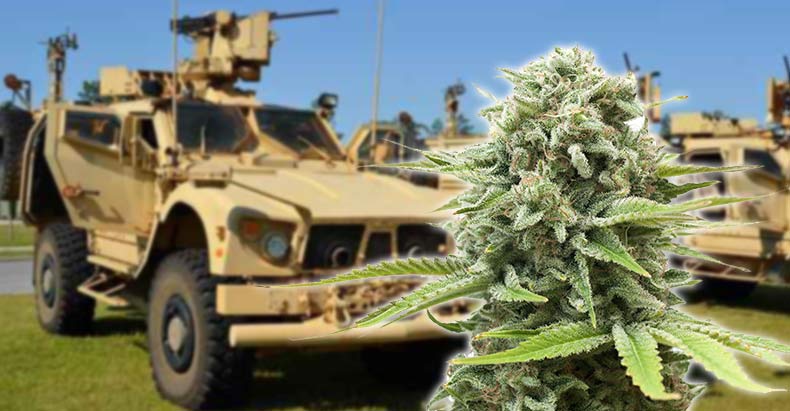 By Carey Wedler
By Carey Wedler
A year after Americans watched in horror as militarized police officers encircled demonstrators and journalists in Ferguson, the Pentagon’s 1033 weapons program—which has been arming local police for years—still faces skepticism and scrutiny.
Documents recently obtained by Mother Jones now reveal that one of the main driving forces of local police efforts to obtain military equipment is not concern over hostage situations or mass shootings, as they claim. It is a desire to perpetuate the War on Drugs.
According to the new information, from 2012 to 2014, police repeatedly requested armored vehicles for the purpose of making marijuana and other drug arrests. While it has long been public information that the incidence of SWAT raids has exploded because of drug prohibition, the new data shows that local police—not just special tactical units—are eager to fortify their crusade against drug users.
Mother Jones reported that “A quarter of the 465 requests projected using the vehicles for drug enforcement.”
Though the Pentagon originally launched its 1033 program in the 1990s—explicitly to bolster the federal government’s crackdown on drugs—the program came to be construed as a defensive strategy against dangerous situations following 9/11. On one hand, the new revelations that police are requesting military equipment to enforce drug laws are in line with the original stated purpose of the program. On the other hand, rather than acknowledging this, police appear to be denying that they want the equipment for drug busts.
Jim Pasco of the Fraternal Order of Police—a de facto police union and advocacy group known for aggressively defending officers accused of brutality and misconduct—denied the equipment is requested to police marijuana and other illicit substances. “In reality, they’re almost exclusively used as defensive tools,” he said. “It’s a rare drug enforcement case that would require an MRAP. We’re talking barricaded shooters and downed officers.”
 But the FOIA documents directly contradict Pasco’s description of police motives. Mother Jones notes that in at least seven separate cases, police specifically cited marijuana as a reason to obtain an armored vehicle. In 2012, Sheriff Tom Bosenko of Shasta County, California requested two armored vehicles to be “used during apprehension of suspects in both Marijuana eradications and during high risk search warrant service for drug offenders.” Marijuana, tied with methamphetamines, was the drug most cited by police applying for MRAPs.
But the FOIA documents directly contradict Pasco’s description of police motives. Mother Jones notes that in at least seven separate cases, police specifically cited marijuana as a reason to obtain an armored vehicle. In 2012, Sheriff Tom Bosenko of Shasta County, California requested two armored vehicles to be “used during apprehension of suspects in both Marijuana eradications and during high risk search warrant service for drug offenders.” Marijuana, tied with methamphetamines, was the drug most cited by police applying for MRAPs.
Here are some other examples of police requests for military equipment that directly reference marijuana:
Trinity County, California: “The sheriff’s office has applied for HIDTA designation, due to the abundance of marijuana cultivation and trafficking. Additionally, the increase in marijuana production has resulted in an increase in violent crime.”
Polk County, Oregon: “The vehicle will be used for eradication efforts of those large scale [marijuana] grows that are becoming more and more prevalent.”
Charlotte County, Florida: “Rural areas in much of Charlotte County. Many SWAT search warrants served in these areas for large marijuana grow operations.”
Clearwater County, Idaho: “The MRAP will be used for drug and Marijuana eradication. The nearest MRAP is six hours from us.”
Pasco intimated that requests like these do not reflect the actual intentions of police officers. Rather, he suggested that police were simply offering “what they thought the Pentagon wanted to hear.” (as if lying about the reasons for requesting MRAPs is any better than using what amounts to a tank on wheels to fight a plant)
 Nevertheless, police have used MRAPs and other military equipment to conduct drug raids. The Washington Post points out that in many ways, it is wholly unnecessary for local police to have these tools. It notes that “Clearwater County, Idaho, has a population of fewer than 10,000 people. It seems like overkill to keep an armored truck on hand for the purpose of ‘marijuana eradication.’ This is especially true when you consider that in recent years, the number of marijuana grow sites discovered in the entire state of Idaho can be counted on one hand.”
Nevertheless, police have used MRAPs and other military equipment to conduct drug raids. The Washington Post points out that in many ways, it is wholly unnecessary for local police to have these tools. It notes that “Clearwater County, Idaho, has a population of fewer than 10,000 people. It seems like overkill to keep an armored truck on hand for the purpose of ‘marijuana eradication.’ This is especially true when you consider that in recent years, the number of marijuana grow sites discovered in the entire state of Idaho can be counted on one hand.”
Though police departments insist the vehicles are used for active shooter, hostage, and terrorist situations, one ACLU investigation of Massachusetts SWAT teams showed the vast majority of raids had nothing to do with such public safety concerns. Wisconsin’s Kenosha County Police Department, which requested an armored vehicle, went on to raid an animal shelter that was criminally raising a baby deer named Giggles. The Department of Natural Resources seized and killed the deer. In another instance, Ohio State University police requested an MRAP to police football games.
These inflated police concerns over marijuana are outdated at best—and an excuse to obtain more powerful weapons at worst. Either way, citing marijuana as a reason to collect military gear is increasingly outrageous. It remains that in spite of constant police seizures of marijuana and related arrests, the production and distribution of the plant continues to grow—supporting the snowballing notion that the decades-long Drug War is futile, wasteful, and counterproductive.
More importantly, as an avalanche of states legalize recreational and medical marijuana and science continues to unearth new beneficial uses of the plant (while violence decreases in states where it is legal), police fears of marijuana are increasingly ridiculous. Local police and the Pentagon’s refusal to adapt to an evolving social landscape only further discredit the already ominous and rightfully loathed militarization of law enforcement.
Carey Wedler writes for theAntiMedia.org. Anti-Media Radio airs weeknights at 11pm Eastern/8pm Pacific. If you spot a typo, email edits@theantimedia.org.
Carey Wedler joined Anti-Media as an independent journalist in September of 2014. As a senior editor, her topics of interest include the police and warfare states, the Drug War, the relevance of history to current problems and solutions, and positive developments that drive humanity forward. She currently resides in Los Angeles, California, where she was born and raised. Learn more about Wedler here!

That’s not the the real reason they are doing this.
There is an excess of military equipment that in some cases gets left overseas due to the cost of transport and maintenance.
Giving them to the police forces allow staging among the general population for use later.
The american people are not very good at math or obvious signs such as all the ammunition purchased by agencies within the population coupled with this.
They will have all their supplies set up in advance and will only need to walk in and take up their positions.